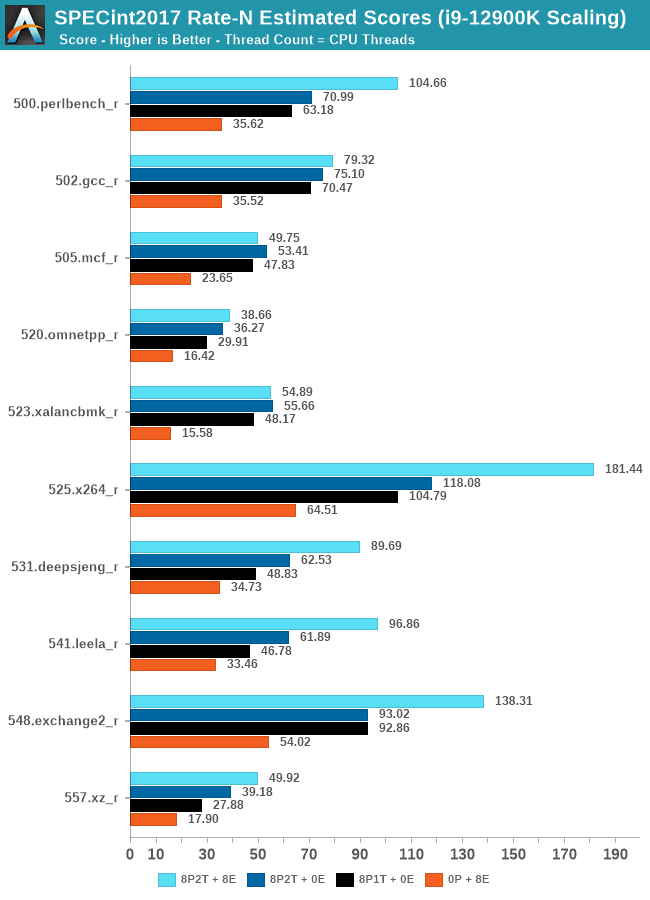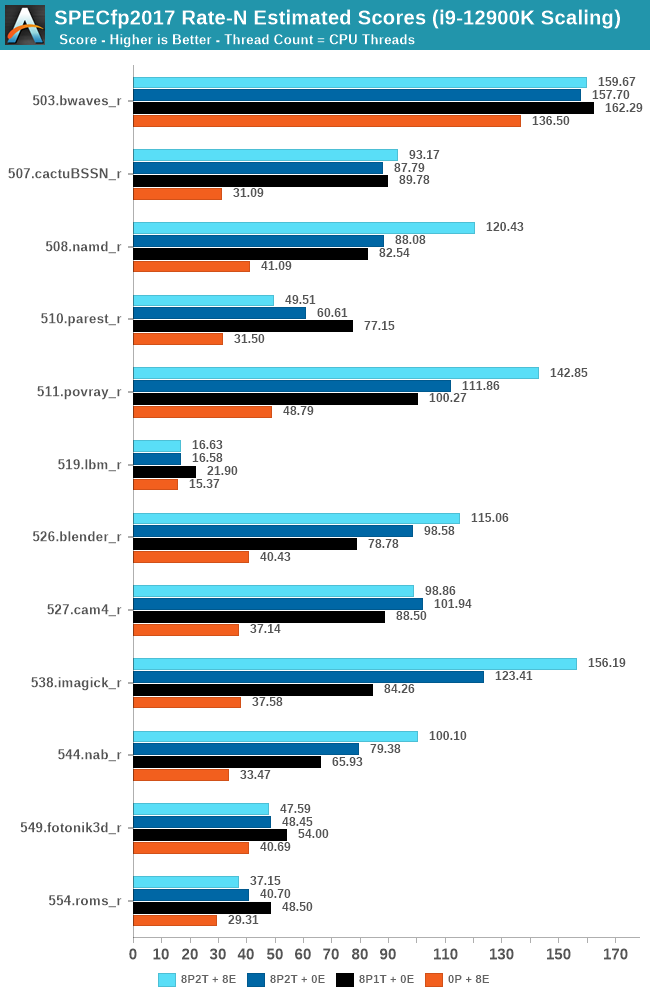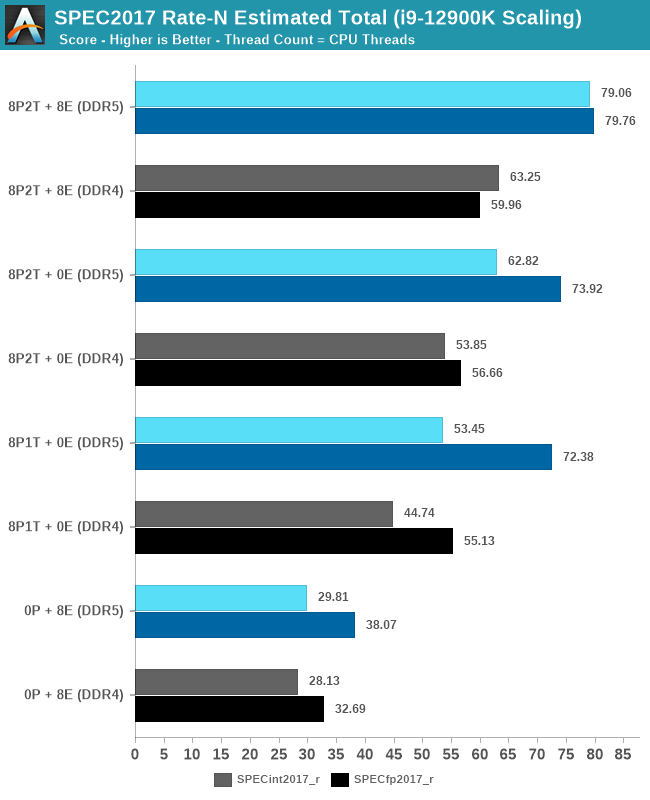The Intel 12th Gen Core i9-12900K Review: Hybrid Performance Brings Hybrid Complexity
by Dr. Ian Cutress & Andrei Frumusanu on November 4, 2021 9:00 AM ESTCPU Tests: SPEC MT Performance - P and E-Core Scaling
Update Nov 6th:
We’ve finished our MT breakdown for the platform, investigating the various combination of cores and memory configurations for Alder Lake and the i9-12900K. We're posting the detailed scores for the DDR5 results, following up the aggregate results for DDR4 as well.
The results here solely cover the i9-12900K and various combinations of MT performance, such as 8 E-cores, 8 P-cores with 1T as well as 2T, and the full 24T 8P2T+8E scenario. The results here were done on Linux due to easier way to set affinities to the various cores, and they’re not completely comparable to the WSL results on the previous page, however should be within small margins of error for most tests.

In the integer suite, the E-cores are quite powerful, reaching scores of around 50% of the 8P2T results, or more.
Many of the more core-bound workloads appear to very much enjoy just having more cores added to the suite, and these are also the workloads that have the largest gains in terms of gaining performance when we add 8 E-cores on top of the 8P2T results.
Workloads that are more cache-heavy, or rely on memory bandwidth, both shared resources on the chip, don’t scale too well at the top-end of things when adding the 8 E-cores. Most surprising to me was the 502.gcc_r result which barely saw any improvement with the added 8 E-cores.
More memory-bound workloads such as 520.omnetpp or 505.mcf are not surprising to see them not scale with the added E-cores – mcf even seeing a performance regression as the added cores mean more memory contention on the L3 and memory controllers.

In the FP suite, the E-cores more clearly showcase a lower % of performance relative to the P-cores, and this makes sense given their design. Only few more compute-bound tests, such as 508.namd, 511.povray, or 538.imagick see larger contributions of the E-cores when they’re added in on top of the P-cores.
The FP suite also has a lot more memory-hungry workload. When it comes to DRAM bandwidth, having either E-cores or P-cores doesn’t matter much for the workload, as it’s the memory which is bottlenecked. Here, the E-cores are able to achieve extremely large performance figures compared to the P-cores. 503.bwaves and 519.lbm for example are pure DRAM bandwidth limited, and using the E-cores in MT scenarios allows for similar performance to the P-cores, however at only 35-40W package power, versus 110-125W for the P-cores result set.
Some of these workloads also see regressions in performance when adding in more cores or threads, as it just means more memory traffic contention on the chip, such as seen in the 8P2T+8E, 8P2T regressions over the 8P1T results.

What’s most interesting here is the scaling of performance and the attribution between the P-cores and the E-cores. Focusing on the DDR5 set, the 8 E-cores are able to provide around 52-55% of the performance of 8 P-cores without SMT, and 47-51% of the P-cores with SMT. At first glance this could be argued that the 8P+8E setup can be somewhat similar to a 12P setup in MT performance, however the combined performance of both clusters only raises the MT scores by respectively 25% in the integer suite, and 5% in the FP suite, as we are hitting near package power limits with just 8P2T, and there’s diminishing returns on performance given the shared L3. What the E-cores do seem to allow the system is to allows to reduce every-day average power usage and increase the efficiency of the socket, as less P-cores need to be active at any one time.










474 Comments
View All Comments
Oxford Guy - Sunday, November 7, 2021 - link
‘or maybe switch off their E-cores and enable AVX-512 in BIOS’This from exactly the same person who posted, just a few hours ago, that it’s correct to note that that option can disappear and/or be rendered non-functional.
I am reminded of your contradictory posts about ECC where you mocked advocacy for it (‘advocacy’ being merely its mention) and proceeded to claim you ‘wish’ for more ECC support.
Once again, it’s helpful to have a grasp of what one actually believes prior to posting. Allocating less effort to posting puerile insults and more toward substance is advised.
mode_13h - Sunday, November 7, 2021 - link
> This from exactly the same person who posted, just a few hours ago, that it’s> correct to note that that option can disappear and/or be rendered non-functional.
You need to learn to distinguish between what Intel has actually stated vs. the facts as we wish them to be. In the previous post you reference, I affirmed your acknowledgement that the capability disappearing would be consistent with what Intel has actually said, to date.
In the post above, I was leaving open the possibility that *maybe* Intel is actually "cool" with there being a BIOS option to trade AVX-512 for E-cores. We simply don't know how Intel feels about that, because (to my knowledge) they haven't said.
When I clarify the facts as they stand, don't confuse that with my position on the facts as I wish them to be. I can simultaneously acknowledge one reality, which maintaining my own personal preference for a different reality.
This is exactly what happened with the ECC situation: I was clarifying Intel's practice, because your post indicated uncertainty about that fact. It was not meant to convey my personal preference, which I later added with a follow-on post.
Having to clarify this to an "Oxford Guy" seems a bit surprising, unless you meant like Oxford Mississippi.
> you mocked advocacy
It wasn't mocking. It was clarification. And your post seemed more to express befuddlement than expressive of advocacy. It's now clear that your post was a poorly-executed attempt at sarcasm.
Once again, it's helpful not to have your ego so wrapped up in your posts that you overreact when someone tries to offer a factual clarification.
Oxford Guy - Monday, November 8, 2021 - link
I now skip to the bottom of your posts If I see more of the same preening and posing, I spare myself the rest of the nonsense.mode_13h - Tuesday, November 9, 2021 - link
> If I see more of the same preening and posing, I spare myself the rest of the nonsense.Then I suggest you don't read your own posts.
I can see that you're highly resistant to reason and logic. Whenever I make a reasoned reply, you always hit back with some kind of vague meta-critique. If that's all you've got, it can be seen as nothing less than a concession.
O-o-o-O - Saturday, November 6, 2021 - link
Anyone talking about dumping x64 ISA?I don't see AVX-512 a good solution. Current x64 chips are putting so much complexity in CPU with irrational clock speed that migrating process-node further into Intel4 on would be a nightmare once again.
I believe most of the companies with in-house developers expect the end of Xeon-era is quite near, as most of the heavy computational tasks are fully optimized for GPUs and that you don't want coal burning CPUs.
Even if it doesn't come in 5 year time-frame, there's a real threat and have to be ahead of time. After all, x86 already extended its life 10+ years when it could have been discontinued. Now it's really a dinosaur. If so, non-server applications would follow the route as well.
We want more simple / solid / robust base with scalability. Not an unreliable boost button that sometimes do the trick.
SystemsBuilder - Saturday, November 6, 2021 - link
I don't see AVX-512 that negatively it is just the same as AVX2 but double the vectors size and a with a richer instruction set. I find it pretty cool to work with especially when you've written some libraries that can take advantage of it. As I wrote before, it looks like Golden cove got AVX-512 right based on what Ian and Andrei uncovered. 0 negative offset (e.g. running at full speed), power consumption not much more than AVX2, and it supports both FP16 and BP16 vectors! I think that's pretty darn good! I can work with that! Now I want my Sapphire rapids with 32 or 48 Golden cove P cores! No not fall 2022 i want it now! lolmode_13h - Saturday, November 6, 2021 - link
> When you optimize code today (for pre Alder lake CPUs) to take advantage> of AVX-512 you need to write two paths (at least).
Ah, so your solution depends on application software changes, specifically requiring them to do more work. That's not viable for the timeframe of concern. And especially not if its successor is just going to add AVX-512 to the E-cores, within a year or so.
> There are many levels of AVX-512 support and effectively you need write customized
> code for each specific CPUID
But you don't expect the capabilities to change as a function of which thread is running, or within a program's lifetime! What you're proposing is very different. You're proposing to change the ABI. That's a big deal!
> It is absolutely possible and it will come with time.
Or not. ARM's SVE is a much better solution.
> I think in the future P and E cores might have more than just AVX-512 that is different
On Linux, using AMX will require a thread to "enable" it. This is a little like what you're talking about. AMX is a big feature, though, and unlike anything else. I don't expect to start having to enable every new ISA extension I want to use, or query how many hyperthreads actually support - this becomes a mess when you start dealing with different libraries that have these requirements and limitations.
Intel's solution isn't great, but it's understandable and it works. And, in spite of it, they still delivered a really nice-performing CPU. I think it's great if technically astute users have/retain the option to trade E-cores for AVX-512 (via BIOS), but I think it's kicking a hornets nest to go down the path of having a CPU with asymmetrical capabilities among its cores.
Hopefully, Raptor Lake just adds AVX-512 to the E-cores and we can just let this issue fade into the mists of time, like other missteps Intel & others have made.
SystemsBuilder - Saturday, November 6, 2021 - link
I too believe AVX-512 exclusion in the E cores it is transitory. next gen E cores may include it and the issue goes away for AVX-512 at least (Raptor Lake?). Still there will be other features that P have but E won't have so the scheduler needs to be adjusted for that. This will continue to evolve with every generation of E and P cores - because they are here to stay.I read somewhere a few months ago but right now i do not remember where (maybe on Anandtech not sure) that the AVX-512 transistor budget is quite small (someone measured it on the die) so not really a big issue in terms of area.
AMX is interesting because where AVX-512 are 512 bit vectors, AMX is making that 512x512 bit matrices or tiles as intel calls it. Reading the spec on AMX you have BF16 tiles which is awesome if you're into neural nets. Of course gpus will still perform better with matrix calculations (multiplications) but the benefit with AMX is that you can keep both the general CPU code and the matrix specific code inside the CPU and can mix the code seamlessly and that's gonna be very cool - you cut out the latency between GPU and CPU (and no special GPU API's are needed). but of course you can still use the GPU when needed (sometimes it maybe faster to just do a matrix- matrix add for instance just inside the CPU with the AMX tiles) - more flexibility.
Anyway, I do think we will run into a similar issue with AMX as we have the AVX-512 on Alder Lake and therefore again the scheduler needs to become aware of each cores capabilities and each piece of code need to state what type of core they prefer to run on: AVX2, AVX-512, AMX capable core etc (the compliers job). This way the scheduler can do the best job possible with every thread.
There will be some teething for a while but i think this is the direction it is going.
mode_13h - Sunday, November 7, 2021 - link
The difference is that AMX is new. It's also much more specialized, as you point out. But that means that they can place new hoops for code to jump through, in order to use it.It's very hard to put a cat like AVX-512 back in the bag.
SystemsBuilder - Saturday, November 6, 2021 - link
To be clear, I also want to add that the way code is written today (in my organization) pre Alder Lake code base. Every time we write a code path for AVX512 we need to write a fallback code path incase the CPU is not AVX-512 capable. This is standard (unless you can control the execution H/W 100% - i.e. the servers).Does not mean all code has to be duplicated but the inner loops where the 80%/20% rule (i.e. 20% of the code that consumes 80% of the time, which in my experience often becomes like the 99%/1% rule) comes into play that's where you write two code paths:
1 for AVX-512 in case it CPU is capable and
2 with just AVX2 in case CPU is not capable
mostly this ends up being just as I said the inner most loops, and there are excellent broadly available templates to use for this.
Just from a pure comp sci perspective it is quite interesting to vectorize code and see the benefits - pretty cool actually.